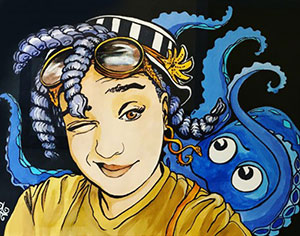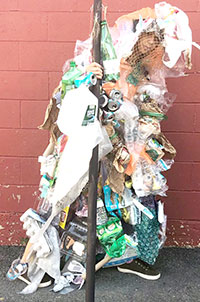
“EHawk” by mixed media visual artist Liz LaManche, one of the dozens of Somerville artists participating in last weekend’s virtual SOS.
By Isabel Sami
Last weekend, the annual Somerville Open Studios (SOS) event took place, but not in its traditional form. The citywide art event happened online from noon to 6:00 p.m. on the SOS website, featuring virtual galleries by 336 artists, and also on the SOS YouTube channel, where nearly 30 artists posted videos of their work and studios. During the event, six artists held Zoom livestream tours of their studios for virtual audiences.
For the past 22 years, Somerville Open Studios has been an event where artists in the city open their doors to visitors who want to tour these artistic spaces. All forms of visual art are featured, including painting, printmaking, jewelry, photography, and fiber arts.
During the weekend, there is normally a trolley system in place to transport visitors easily around the city to view the exhibits and studios, and the city lifts residential parking restrictions so visitors can go between studios easily. However, with the coronavirus pandemic causing citywide closures, shelter-at-home orders, and social distancing guidelines, holding the event in its usual fashion was impossible.
The cancellation of the physical event was disappointing according to SOS publicity coordinator Thea Paneth, who said, “Everyone was absolutely devastated. It’s all artists and members of the community working together to make the event happen. Having to cancel it was really distressing, but we saw the way things were going and that it wasn’t going to be possible or safe to open.”

“Plastic/Trash/Hobo” by Katya Popova.
SOS Board President Hilary Scott said that after cancelling the in-person event, the plans to pivot to a virtual platform were immediate. During the initial discussion about the online transition, SOS organizers decided on two distinct parts: a virtual gallery and livestreams.
With a virtual gallery on the SOS website, artists displayed four to eight pieces of their work, with an added feature of posting video tours of their studios and creative spaces on SOS’s YouTube channel.
After figuring out the gallery, the team then asked, “How can we salvage the live aspect?” They came up with a plan to do Zoom livestreams, scheduling times for artists to broadcast and invite people into their space. These features brought both live and pre-recorded factors to the event, and links to the art and videos made it even more accessible.
“We’re excited that the YouTube channel is something we can keep going and add more aspects to year-round,” Scott said. As a member of SOS since it began 22 years ago, Scott was disappointed to have to cancel the in-person event as they were in the homestretch, but he is still pleased with how the event transitioned. He believes the SOS team “made lemonade when the world served us lemons.”
“We can come out of it with a more interesting and fuller experience,” Scott said. “SOS is such a physical experience. It’s opening up your door and having people walk in, and having to explain to the artist community that they could do this virtually was the challenge,” he said, adding, “We said, ‘we can do this, and it’s worth doing.’”
Scott believes that the online approach makes SOS more broadly accessible, as people who are not in Somerville can find the YouTube channel and wander into the artists’ studios whenever from wherever.
Though the virtual event was a success, Scott felt it was bittersweet since the weather last weekend was perfect, and he missed seeing the hundreds of visitors, especially enthusiastic kids who usually attend.
Changing the event was sudden, but Paneth said that artists and volunteers at SOS offered their individual expertise to join the collective activity of transitioning online. Everyone on the team worked remotely, which was new since SOS members normally meet in each other’s living rooms, but now meetings take place over Zoom. Scott said there was a bit of a learning curve at first, but the team got used to the new form of communication.
Watercolor artist and designer Katya Popova agreed that there was a learning curve for those involved. Popova worked on the virtual transition team and was an early advocate of switching online and using Zoom to keep the event going. “We were really intensely working when the whole pandemic happened,” she said. “No one was sure if we wanted to cancel the event or if things would get better. We started thinking about other possibilities.”
With social distancing forcing the team members to work remotely, Popova worked from New Hampshire, and said that she grew closer with SOS members over virtual meetings. “I’m very grateful that the virtual work happened so we were able to pull this all together,” Popova said, adding, “It’s kind of a warm feeling, so I’m grateful to the people involved, because they definitely made it all work.”
Scott voiced similar sentiments. “It’s a wonderful thing. Some open studios are organized by arts councils, but this is organized hands-on by SOS artists and we do the work ourselves. It means something. We build community amongst each other working together, and it’s really been wonderful to be a part of it all these years.”
The SOS website and YouTube channel still have all the artists’ galleries featured, and anyone interested in seeing the work can visit at https://www.somervilleopenstudios.org.












Reader Comments